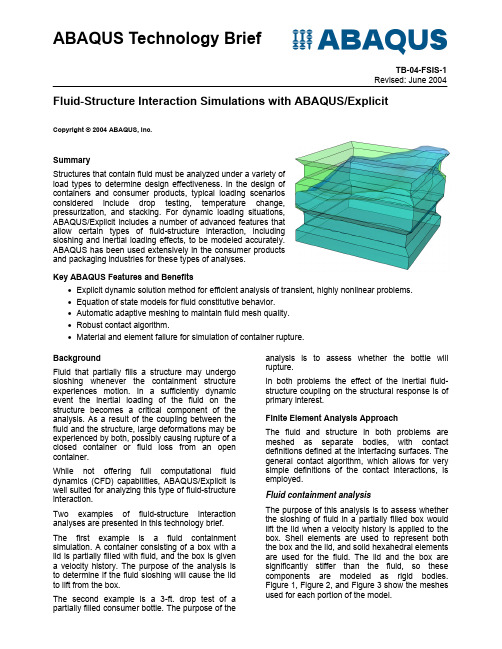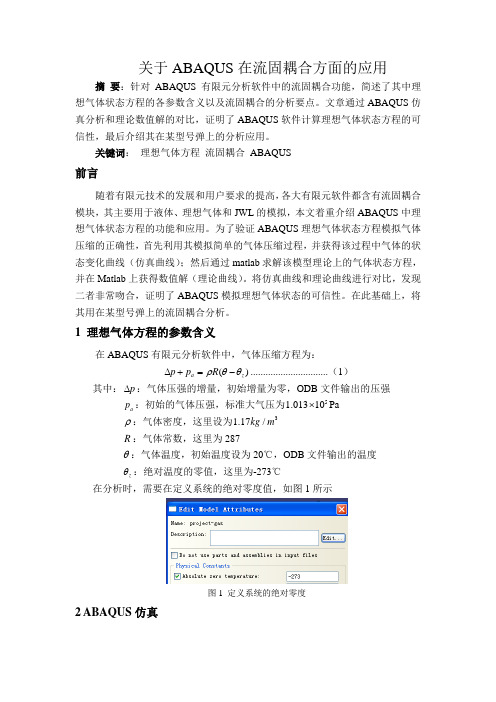abaqus FSI流固耦合教程 课件
Abaqus经典教程PPT学习课件

rigid-floor
➢Modeling Space
2D Planar
➢Type
Analytical rigid
➢Approximate size
200
3/2/2020
L2.9
创 建 新 PA RT 之 刚 性 地 面 2
➢如左图,画一个 100X100的正方形, 来模拟刚性地面。 ➢点击鼠标中键或 点击按钮 , 完成。 200
3/2/2020
L2.29
SEED EDGE
指定边上网格尺寸
1、选取要单独设置网格密度的边 2、指定边上网格尺寸
3/2/2020
L2.30
SEED MESH
Seed Edge:Biased设置边上网格密度渐变 Delete Part Seeds去除Part密度设置 Delete Edge Seeds去除边密度设置
L2.48
定位
定位,与Translate to平移到类似
现以Create Round or Fillet为例说明如何倒圆角: 1、选择要进行倒圆角的边(按住Shift,左键拾取可 进行多选)
2、指定圆角半径
3/2/2020
L2.16
去倒角
Repair Small Faces可以理解为去除小面。
Repair Small Faces通常用于简化模型,如去倒角 1、选择要去掉的小面(按住Shift,左键拾取可 进行多选)
体网格控制
三维模型单元形状: Hex
仅包含六面体单元
Hex-dominated
六面体单元为主,楔形单 元为辅
Tet
仅包含四面体单元
Wedge
仅包含楔形单元
3/2/2020
技术简介-ABAQUS显式的流固耦合仿真

ABAQUS Technology BriefTB-04-FSIS-1 Revised: June 2004Fluid-Structure Interaction Simulations with ABAQUS/ExplicitCopyright © 2004 ABAQUS, Inc.SummaryStructures that contain fluid must be analyzed under a variety of load types to determine design effectiveness. In the design of containers and consumer products, typical loading scenarios considered include drop testing, temperature change, pressurization, and stacking. For dynamic loading situations, ABAQUS/Explicit includes a number of advanced features that allow certain types of fluid-structure interaction, including sloshing and inertial loading effects, to be modeled accurately. ABAQUS has been used extensively in the consumer products and packaging industries for these types of analyses.Key ABAQUS Features and Benefits• Explicit dynamic solution method for efficient analysis of transient, highly nonlinear problems. • Equation of state models for fluid constitutive behavior. • Automatic adaptive meshing to maintain fluid mesh quality. • Robust contact algorithm. • Material and element failure for simulation of container rupture.BackgroundFluid that partially fills a structure may undergo sloshing whenever the containment structure experiences motion. In a sufficiently dynamic event the inertial loading of the fluid on the structure becomes a critical component of the analysis. As a result of the coupling between the fluid and the structure, large deformations may be experienced by both, possibly causing rupture of a closed container or fluid loss from an open container.While not offering full computational fluid dynamics (CFD) capabilities, ABAQUS/Explicit is well suited for analyzing this type of fluid-structure interaction.Two examples of fluid-structure interaction analyses are presented in this technology brief.The first example is a fluid containment simulation. A container consisting of a box with a lid is partially filled with fluid, and the box is given a velocity history. The purpose of the analysis is to determine if the fluid sloshing will cause the lid to lift from the box.The second example is a 3-ft. drop test of a partially filled consumer bottle. The purpose of theanalysis is to assess whether the bottle will rupture.In both problems the effect of the inertial fluidstructure coupling on the structural response is of primary interest.Finite Element Analysis ApproachThe fluid and structure in both problems are meshed as separate bodies, with contact definitions defined at the interfacing surfaces. The general contact algorithm, which allows for very simple definitions of the contact interactions, is employed.Fluid containment analysisThe purpose of this analysis is to assess whether the sloshing of fluid in a partially filled box would lift the lid when a velocity history is applied to the box. Shell elements are used to represent both the box and the lid, and solid hexahedral elements are used for the fluid. The lid and the box are significantly stiffer than the fluid, so these components are modeled as rigid bodies. Figure 1, Figure 2, and Figure 3 show the meshes used for each portion of the model.Figure 1: Rigid element mesh for the lid. Figure 2: Solid element mesh for the fluid.The box is constrained to remain on the horizontal plane throughout the analysis; that is, it is not allowed to rotate in space or to lift from the ground. Gravity loads are applied to the lid and to the fluid; and a sinusoidal, time-varying velocity is applied to the box. The velocity history is such that the box moves only in the horizontal plane; no vertical motion has been prescribed.The lid simply sits on the box; therefore, an airtight seal is not assumed at this interface. Consequently, there is no gas pressure in the space above the fluid. If the effect of a gas were to be included in the analysis, the following modeling approaches could be taken:• The gas could be modeled with solid elements (using an equation of state material model) and a contact interface between the fluid and the gas.• A surface-based hydrostatic fluid cavity could be defined for the gas.• A simple surface pressure load could be applied to the free surface of the fluid.Bottle drop analysisThe purpose of this analysis is to determine the integrity of a fluid-filled bottle when dropped from a height of 3 ft. Shell elements are used to represent the bottle, and solid hexahedral elements are used for the fluid. A single rigid element is used to model the floor. The undeformed model is shown in Figure 4.Figure 3: Rigid element mesh for the box.Contact is defined between the lid and the box and between the fluid and the entire container. No attachment has been defined between the lid and the box.ABAQUS has a number of contact algorithms; the general contact capability is the easiest to use and the most comprehensive. An advantage of the general contact algorithm is its ability to include the “edge-to-edge” contact at the top of the box in the contact definition. With edge-toedge contact, geometric feature edges, perimeter edges of shell and solid elements, and segments of beam and truss elements can be included in the contact domain. This feature allows contact interactions that cannot be detected as penetrations of nodes into faces to be enforced.Figure 4: Undeformed bottle, fluid, and rigid floor.Contact is defined between the bottle and the fluid and between the bottle and the floor. Gravity loads are applied to both the fluid and the container. The initial conditions of the bottle are consistent with a drop of 3 ft. The bottle is positioned slightly above the point of contact, and the fluid and the container are given an initial velocity of 168 in/s. The rigid floor is fully constrained.2The elastic-plastic constitutive properties of the bottle are those of high-density polyethylene (HDPE). A failure model is included for the HDPE, based on the tensile hydrostatic pressure stress in the elements. This failure model allows elements to be deleted from the mesh once failure has been detected. The general contact algorithm will automatically eliminate failed elements from the contact domain and update contact surfaces so that the resulting surface lies on elements that have not failed; surface erosion is a key capability in modeling the contact as the fluid sloshes out of a broken container. The base of the bottle is thicker than the walls, making the material in this region slightly more resistant to failure. This region is shown in red in Figure 5.Figure 5: Regions of different thicknesses in the bottle.The effect of any gas pressure in the bottle has been ignored. In this case the size of the enclosed gas cavity is small compared to the fluid, so the effect of the gas has been assumed negligible. The additional features common to both models are discussed below.Equation of state material model In both examples the fluid is considered as incompressible and inviscid. An equation of state material model is typically used for such applications and is chosen here. The equation of state determines the volumetric strength of a hydrodynamic material and specifies the pressure in the material as a function of density and internal energy. With this approach the deviatoric strength of the material is considered separately and can be included if viscous behavior is needed.Section properties of the fluid elements ABAQUS/Explicit offers alternative kinematic formulations for solid hexahedral elements: when appropriate for the analysis, choosing a nondefault formulation can significantly reduce computational expense. For the elementsrepresenting the fluid in the present simulations, an orthogonal formulation is chosen. This formulation provides a good balance between computational speed and accuracy. If the objective of the analyses was to determine the shape of the fluid free surface with the highest possible accuracy, the default kinematic formulation would be appropriate. However, because the inertial coupling of the fluid and structure is of primary importance, a less computationally expensive formulation can be used.Automatic adaptive meshing for the fluid Automatic adaptive meshing in ABAQUS/Explicit allows it to maintain high-quality element shapes as the fluid undergoes large deformation during sloshing. While a regular Lagrangian approach could be used to model the fluid, the elements would become very distorted after a short period of time. Adaptive meshing maintains well-shaped elements, allowing for a longer simulation time by periodically adjusting the element shapes in the fluid domain. Initially regular, relatively coarse meshes of hexahedral elements are used for the fluid. A single adaptive mesh domain that incorporates the entire fluid region is defined. In the bottle drop example a graded smoothing objective is used so that the initial mesh gradation of the water is preserved approximately while continuous adaptive meshing is performed. In addition, the default curvature refinement weighting is increased, causing the adaptive meshing algorithm to retain more elements in areas of high concave curvature.Analysis Results and Discussion Some representative results from the analyses are presented.Fluid containment analysis Figure 6–Figure 9 display the deformed shape of the fluid at several points of the analysis.Figure 6: Deformed shape after 0.12 seconds.3No restraint mechanism is applied to the lid; it is simply placed on the box. Since the lid is modeled as rigid, the history of the vertical displacement of the center of the lid (Figure 10) clearly shows that the sloshing induced in the fluid will cause the lid to separate from the box.Figure 7: Deformed shape after 0.375 seconds.Figure 10: History of vertical displacement of the lid center.Bottle drop analysisThe deformation and damage sustained by the bottle are shown in Figure 11–Figure 15.Figure 8: Deformed shape after 0.6 seconds.Figure 11: Deformed shape after 6.3 milliseconds.Figure 9: Deformed shape after 0.877 seconds.The deformed shape plots show the large deformations achieved by the fluid as the box moves. The automatic adaptive meshing capability in ABAQUS/Explicit maintains well shaped elements in the fluid, allowing the fluid to achieve high levels of deformation.Figure 12: Deformed shape after 10.8 milliseconds.4Figure 13: Deformed shape after 12.6 milliseconds.Figure 15: Deformed shape after 18 milliseconds.The deformed shape plots clearly show the buckling response of the bottle on impact and the instant of rupture (the failed elements have been removed from the plots). The tensile failure material model produces an output variable that indicates whether failure has occurred for each element, and the Visualization module in ABAQUS/CAE can remove the failed elements from the display. As the failure propagates, it can be seen that the tear travels down the corner of the bottle and turns along the interface between the thicker base section and the thinner bottle wall.Figure 14: Deformed shape after 14.4 milliseconds.ConclusionsAs demonstrated in the above analyses, ABAQUS/Explicit can be used to incorporate the effects of sloshing-type fluid-structure interaction into dynamic analyses. While it is generally not possible in ABAQUS/Explicit to model complex fluid flow behaviors or phenomena such as freesurface interactions and splashing, inclusion of the inertial loading caused by the fluid deformation allows for a more complete simulation capability.ABAQUS ReferencesFor additional information on the ABAQUS capabilities referred to in this brief, see the following ABAQUS Version 6.4 documentation references:• Analysis User’s Manual- “Explicit dynamic analysis,” Section 6.3.3 - “Adaptive meshing,” Section 7.16 - “Equation of state,” Section 10.9.1• Example Problems Manual- “Cask drop with foam impact limiter,” Section 2.1.12 - “Water sloshing in a baffled tank,” Section 2.1.14• Benchmarks Manual- “Water sloshing in a pitching tank,” Section 1.11.75。
abaqus FSI流固耦合教程 课件

学习交流PPT
1
目录
• 1、abaqus/CFD模块简介 • 2、abaqus流固耦合简介 • 3、流固耦合操作与实例 • 4、流热耦合操作与实例
学习交流PPT
2
1、abaqus/CFD模块简介
学习交流PPT
3
1 abaqus/CFD模块简介
1.1 计算流体动力学基础
• 单元类型DC3D8 • 初始温度293K • 体热通量50mW/s/mm3 • 瞬态热传递分析步,初始增量0.01s;CFD分析;
总仿真时间15s
学习交流PPT
50
4、热流耦合操作与实例
学习交流PPT
51
4、热流耦合操作与实例
后处理:
temperature
pressure
velocity vector
学习交流PPT
46
4、流热耦合操作与实例
学习交流PPT
47
4、流热耦合操作与实例
实例题目:单芯片的电路板流热耦合分析[1] 分析对象:芯片与周围介质 分析平台:ABAQUS 6.12 分析类型:双向流热耦合 分析目标:了解芯片传导换热的状况
[1]Conjugate heat transfer analysis of a component-mounted electronic circuit board. Abaqus Example Problems Manual 6.1.Abaqus 6.12 Documentation.
学习交流PPT
42
3、流固耦合操作与实例
学习交流PPT
43
3、流固耦合操作与实例
实例题目:管道流体双向耦合的动力学模拟分析[1]
关于ABAQUS在流固耦合方面的应用

关于ABAQUS 在流固耦合方面的应用摘 要:针对ABAQUS 有限元分析软件中的流固耦合功能,简述了其中理想气体状态方程的各参数含义以及流固耦合的分析要点。
文章通过ABAQUS 仿真分析和理论数值解的对比,证明了ABAQUS 软件计算理想气体状态方程的可信性,最后介绍其在某型号弹上的分析应用。
关键词: 理想气体方程 流固耦合 ABAQUS前言随着有限元技术的发展和用户要求的提高,各大有限元软件都含有流固耦合模块,其主要用于液体、理想气体和JWL 的模拟,本文着重介绍ABAQUS 中理想气体状态方程的功能和应用。
为了验证ABAQUS 理想气体状态方程模拟气体压缩的正确性,首先利用其模拟简单的气体压缩过程,并获得该过程中气体的状态变化曲线(仿真曲线);然后通过matlab 求解该模型理论上的气体状态方程,并在Matlab 上获得数值解(理论曲线)。
将仿真曲线和理论曲线进行对比,发现二者非常吻合,证明了ABAQUS 模拟理想气体状态的可信性。
在此基础上,将其用在某型号弹上的流固耦合分析。
1 理想气体方程的参数含义在ABAQUS 有限元分析软件中,气体压缩方程为:()a z p p R ρθθ∆+=- (1)其中:p ∆:气体压强的增量,初始增量为零,ODB 文件输出的压强 a p :初始的气体压强,标准大气压为51.01310⨯Paρ:气体密度,这里设为31.17/kg mR :气体常数,这里为287θ:气体温度,初始温度设为20℃,ODB 文件输出的温度 z θ:绝对温度的零值,这里为-273℃在分析时,需要在定义系统的绝对零度值,如图1所示图1 定义系统的绝对零度2 ABAQUS 仿真建立如图2所示的装配图,气体在一个封闭的环境内受到活塞的压缩。
假设整个过程没有任何能量的损失,及活塞气体和活塞之间没有热传递,且活塞以一定的速度向前运动。
图2 气体未压缩和压缩后体积的变化在设置模型过程中,活塞和气体之间的接触通过inp文件的关键字实现,经过实践证明,这样的定义方式可以有效避免气体的泄露。
第九讲 流固耦合

自动耦合
欧拉施加的压力通过拉格朗日 表面进行积分得到节点力
拉格朗日相当于给欧拉施加 了流动约束
它们之间不考虑摩擦
部分覆盖的单元被自动合并 ( Blended) 自动接触能够考虑侵蚀
Blended cells
拉格朗日体的(Lagrange part)整个外表面自动和欧 拉进行接触 欧拉施加压力给拉格朗日
刚体欧拉耦合
全耦合– 水下爆炸
水下爆炸对舰艇的影响
刚体欧拉耦合
刚体壳
水和空气使用3D多物质欧拉
全耦合 – 水面爆炸对舰艇的影响
靠近舰艇的空气中爆炸
刚体欧拉耦合 刚体壳 水和空气使用3D多物质欧拉
全耦合 – 爆炸对舰艇壳体的冲击变形
靠近舰艇的空气中爆炸
刚体欧拉耦合 刚体壳 水和空气使用3D多物质欧拉
全耦合 - 爆炸侵彻钢筋混凝土
Euler Blast
Lagrange Concrete
Beam Reinforcements
全耦合- 地雷爆炸
空气爆炸
全耦合
破片碰撞
接触
侵蚀
余留的惯性
全耦合 – 爆炸侵彻 RPG
RPG爆炸冲击波和破片对 CFRP翼箱的破坏
空气中爆炸采用冲击波求 解器 RPG壳体 (破片) 和翼箱
全耦合 – 玻璃碎片
有效减低飞散玻璃碎片的危 险,德国国防部对各种汽车 玻璃进行了安全评估 :
Test in Large Blast Simulator
《Abaqus教程》课件

06
Abaqus未来发展与展望
人工智能与机器学习在Abaqus中的应用
预测模型
利用机器学习技术,对Abaqus模拟结果进行预测 ,提高预测精度。
自动化优化
结合人工智能算法,实现Abaqus模型的自动优化 ,提高设计效率。
自动化校准
利用机器学习技术,自动校准Abaqus模型的参数 ,减少人工干预。
标准化接口
推动Abaqus的标准化接口发展,促进软件之间的互操作性。
THANKS FOR WATCHING
感谢您的观看
接触表面处理
在进行接触设置时,需要对接触表面进行处理,如 粗糙度、摩擦系数等,以确保模拟结果的准确性。
接触条件
在模拟过程中,用户需要设定接触条件,如 接触压力、温度等,以控制模拟的边界条件 。
优化设计
优化目标
用户可以根据实际需求设定优化目标,如最小化重量、最大化刚度 等,以实现结构优化设计。
优化算法
02
Abaqus基本操作
启动与退
启动Abaqus
打开Abaqus软件,选择合适的模块 和许可证。
退出Abaqus
完成操作后,选择“文件”菜单中的 “退出”选项,保存更改并关闭软件 。
模型创建
创建模型
在“模型”菜单中选择“创建模型”选项,选择合适的单位和坐标系。
创建部件
在“模型”菜单中选择“创建部件”选项,输入部件名称和尺寸。
材料模型的发展与挑战
01
02
03
新材料模型
随着新材料的发展,需要 开发新的材料模型以适应 模拟需求。
多物理场耦合
实现多物理场(如热、力 、电等)的耦合模拟,提 高模拟精度。
参数的不确定性
流固耦合分析(FSI)理论详解

流固耦合分析(FSI)流固耦合分析(FSI)是涉及流体和固体之间相互作用的问题研究,其理论包括了几个主要方面:流体力学、固体力学、耦合边界条件、求解器等。
以下是流固耦合分析的详细理论讲解,带有相关公式和尽量详细的说明。
一、流体力学1. 守恒定律质量守恒定律:$$ \frac{\partial \rho}{\partial t} + \nabla \cdot (\rho \mathbf{u}) = 0 $$动量守恒定律:$$ \rho \frac{\partial \mathbf{u}}{\partial t} + \rho (\mathbf{u} \cdot \nabla) \mathbf{u} = \nabla \cdot \tau + \mathbf{f} $$其中,$\rho$是流体密度,$\mathbf{u}$是流体速度,$\tau$是应力张量,$\mathbf{f}$是体力。
2. 纳维-斯托克斯方程$$ \rho \frac{\partial \mathbf{u}}{\partial t} + \rho (\mathbf{u} \cdot \nabla) \mathbf{u} = \nabla \cdot (-p\mathbf{I} + \tau) + \mathbf{f} $$其中,$p$是静压力,$\mathbf{I}$是单位张量。
3. 边界条件(1)速度边界条件:$\mathbf{u} = \mathbf{u}_b$,其中$\mathbf{u}_b$是边界上的速度。
(2)压力边界条件:$p = p_b$,其中$p_b$是边界上的压力。
4. 流体力学求解器常用的流体力学求解器有OpenFOAM、ANSYS Fluent等。
二、固体力学1. 力学基本方程$$ \tau = \sigma\cdot \mathbf{n} $$其中,$\tau$是表面上的接触力,$\sigma$是固体的应力张量,$\mathbf{n}$是表面的单位法向量。
流固耦合过程_教程

湖南大学先进动力流固耦合过程(仅耦合热边界)准备软件:¾AVL-FIRE¾Hypermesh(用于划分和处理网格)¾ABAQUS(熟悉inp文件结构和语句)¾MSC-Patran湖南大学先进动力以AVL-FIRE安装目录下面简单例子为例,位于以下目录:D(安装盘符):\AVL\FIRE\v(版本号)\exam湖南大学先进动力第一步:CFD计算所有设置与例子中保持一致湖南大学先进动力第一步计算CFD的时候,不需要选上Mesh FEM format,只需指定输出Frequency即可。
湖南大学先进动力第一步计算完之后会产生一个htcc 文件,如下图:湖南大学先进动力第二步:耦合面网格及固体网格获取为了便于统一坐标位置和热边界插值,不用例子中的FEM 网格。
FEM 网格将从CFD 网格(cyl.flm )中“抽取”,如下图,在Fire 中导出.nas 格式文件。
湖南大学先进动力在hypermesh中TOOl>faces 板块中把流体网格的外表面抽取,然后删除两端面的面网格选择全部网格(displayed)即可湖南大学先进动力通过3D>elem offset 来获得实体网格湖南大学先进动力第三步:映射(mapping )热边界条件上一步得到的面网格导出为.nas 文件(如sur_mesh_for_mapping.nas )FIRE 中FEM Interface中设置如下两图湖南大学先进动力保存之后,Start ,next 直到如图所示界面,输入-fem –mode=mapping湖南大学先进动力第四步:查看热边界结果(这一步不是必需的,为了Mapping之后会产生一个包含热边界的inp文件,用于后续的固体温度场计算。
湖南大学先进动力映射距离与用例子比较(用三角形面单元)湖南大学先进动力第五步:在MSC-Patran 中做MPC注意:这里的面网格节点号和单元号要与前面用来mapping 的面网格对应上,可以在patran 或者hypermesh 中通过renumber 来实现,固体网格最好也把节点号和单元号renumber ,记下所有的节点号和单元号,以备后用。
- 1、下载文档前请自行甄别文档内容的完整性,平台不提供额外的编辑、内容补充、找答案等附加服务。
- 2、"仅部分预览"的文档,不可在线预览部分如存在完整性等问题,可反馈申请退款(可完整预览的文档不适用该条件!)。
- 3、如文档侵犯您的权益,请联系客服反馈,我们会尽快为您处理(人工客服工作时间:9:00-18:30)。
学习交流PPT
42
3、流固耦合操作与实例
学习交流PPT
43
3、流固耦合操作与实例
实例题目:管道流体双向耦合的动力学模拟分析[1]
分析对象:管道(固)润滑油(流) 分析平台:ABAQUS 6.12 分析类型:双向流固耦合 分析目标:得到管道位移过大的主要影响因素
参考文献
[1]潘海丽,张亚新.管道流体双向耦合的动力学模拟分析[J].中国石油和化工标准与质量,2013,(6).
学习交流PPT
46
4、流热耦合操作与实例
学习交流PPT
47
4、流热耦合操作与实例
实例题目:单芯片的电路板流热耦合分析[1] 分析对象:芯片与周围介质 分析平台:ABAQUS 6.12 分析类型:双向流热耦合 分析目标:了解芯片传导换热的状况
[1]Conjugate heat transfer analysis of a component-mounted electronic circuit board. Abaqus Example Problems Manual 6.1.Abaqus 6.12 Documentation.
学习交流PPT
17
2 abaqus流固耦合简介
学习交流PPT
18
2 abaqus流固耦合简介
适用范围
学习交流PPT
19
2 abaqus流固耦合简介
不适用的范围 震动噪声 利用杆、梁、桁架、线缆建立的模型 喷射成形、铸造、超塑性成形 破裂、渗透分析
学习交流PPT
20
2 abaqus流固耦合简介
2.2操作流程
学习交流PPT
21
2 abaqus流固耦合简介
(1)定义流体介质属性
学习交流PPT
22
2 abaqus流固耦合简介
(2)定义分析步
学习交流PPT
23
2 abaqus流固耦合简介
学习交流PPT
24
2 abaqus流固耦合简介
(3)定义预定义场
学习交流PPT
25
2 abaqus流固耦合简介
• 单元类型DC3D8 • 初始温度293K • 体热通量50mW/s/mm3 • 瞬态热传递分析步,初始增量0.01s;CFD分析;
总仿真时间15s
学习交流PPT
50
4、热流耦合操作与实例
学习交流PPT
51
4、热流耦合操作与实例
后处理:
temperature
pressure
velocity vector
ABAQUS/CFD及流固耦合视频 教程
学习交流PPT
1
目录
• 1、abaqus/CFD模块简介 • 2、abaqus流固耦合简介 • 3、流固耦合操作与实例 • 4、流热耦合操作与实例
学习交流PPT
2
1、abaqus/CFD模块简介
学习交流PPT
3
1 abaqus/CFD模块简介
1.1 计算流体动力学基础
学习交流PPT
13
1 abaqus/CFD模块简介
学习交流PPT
14
1 abaqus/CFD模块简介
1.3 入门实例
学习交流PPT
15
2、abaqus流固耦合简介
学习பைடு நூலகம்流PPT
16
2 abaqus流固耦合简介
2.1 概述 流固耦合即FSI,是指流体的运动会影响固体,
而固体变化又会反过来影响流体运动。
学习交流PPT
48
4、热流耦合操作与实例
1、建立几何模型 PCB板尺寸 7.8X11.6X0.16 cm 芯片尺寸 3X3X0.7 cm 发热块尺寸 1.8X1.8X0.3cm 核心尺寸 0.75X0.75X0.2cm 空气尺寸 27.8X20X12.56 cm
学习交流PPT
49
4、热流耦合操作与实例
(3)定义预定义场
学习交流PPT
26
2 abaqus流固耦合简介
学习交流PPT
27
2 abaqus流固耦合简介
学习交流PPT
28
2 abaqus流固耦合简介
学习交流PPT
29
2 abaqus流固耦合简介
(4)定义边界和载荷
学习交流PPT
30
2 abaqus流固耦合简介
学习交流PPT
31
2 abaqus流固耦合简介
38
2 abaqus流固耦合简介
学习交流PPT
39
2 abaqus流固耦合简介
(5)定义输出变量
学习交流PPT
40
2 abaqus流固耦合简介
可用求解器(6.10版)
学习交流PPT
41
2 abaqus流固耦合简介
可供耦合的求解器
动力隐式求解器(模型1) 动力显式求解器(模型2) 热传递(模型3) 动力温度位移耦合求解器,不含温度求解(模型4)
学习交流PPT
44
3、流固耦合操作与实例
润滑油简化为不可压缩、均匀介质 质量864Kg/m3 动力粘度4.33cp 比定压热容2063J/(Kg.K) 入口速度1.93m/s
单位mm,圆角R100
学习交流PPT
45
3、流固耦合操作与实例
后处理: 1、管道的压力云图 2、管道转弯处的位移随时间变化 3、流体的速度剖面图 4、显示流线
学习交流PPT
32
2 abaqus流固耦合简介
学习交流PPT
33
2 abaqus流固耦合简介
学习交流PPT
34
2 abaqus流固耦合简介
学习交流PPT
35
2 abaqus流固耦合简介
学习交流PPT
36
2 abaqus流固耦合简介
学习交流PPT
37
2 abaqus流固耦合简介
学习交流PPT
学习交流PPT
4
1 abaqus/CFD模块简介
学习交流PPT
5
1 abaqus/CFD模块简介
学习交流PPT
6
1 abaqus/CFD模块简介
学习交流PPT
7
1 abaqus/CFD模块简介
学习交流PPT
8
1 abaqus/CFD模块简介
非稳态分析必须设定初始条件:
压强、速度、温度、湍流数量
学习交流PPT
temperature
52
需要设定的区域:
进口和出口、壁面、远场及其他抽象区域
学习交流PPT
10
1 abaqus/CFD模块简介
学习交流PPT
11
1 abaqus/CFD模块简介
学习交流PPT
12
1 abaqus/CFD模块简介
1.2 abaqus/cfd的介绍 采用基于混合有限体积和有限元元的计算方法 只能采用非可压缩流、基于压力的求解器 可选择层流和湍流 从6.10版开始引入 前后处理及求解都可以在软件中完成
